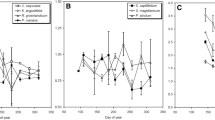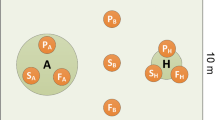Abstract
Background and aims
Organisms that are capable of nitrogen (N) fixation, such as some species of cyanobacteria in biological soil crusts (biocrusts), can be ecologically important especially in low-nutrient dryland ecosystems. In addition, woody plant encroachment is occurring in drylands globally, including many species of N2-fixing shrubs and trees. We determined the effects of nutrient deposition and shrub encroachment by Larrea tridentata on N2-fixation rates of biocrusts and compared these rates to another encroaching shrub, the N2-fixer Prosopis glandulosa in the northern Chihuahuan Desert.
Methods
We used both the acetylene reduction assay (ARA) and the 15N natural abundance techniques to determine N2-fixation rates of biocrusts. We also assessed the effects of nutrient additions on biocrust N2-fixation rates using a long-term N addition experiment started in 2008 that is part of the Nutrient Network (NutNet).
Results
There was no correlation between the ARA and δ15N methods. We found that P. glandulosa likely fixes more N (at least during the spring) than biocrusts based on δ15N content in roots. There was no significant difference in δ15N between P. glandulosa and our reference plant, L. tridentata. δ15N declined in N-fertilized plots presumably because biological nitrogen fixation (BNF) is costly or because added N has negative effects on microbial communities.
Conclusions
Biocrusts fixed less nitrogen than N2-fixing legume shrubs during this sampling period. Nonetheless, biocrusts are still a significant contributor to N2-fixation in these nutrient-poor drylands based on the large proportion of soil surface area occupied by these organisms.




Similar content being viewed by others
Data availability
The datasets generated during and/or analyzed during the current study are available from the corresponding author on reasonable request.
Code availability
The code generated during and/or analyzed during the current study are available from the corresponding author on reasonable request.
Notes
janderso@jornada-vmail.nmsu.edu.
Vince.gutschick@gmail.com.
References
Aranibar JN, Anderson IC, Ringrose S, Macko SA (2003) Importance of nitrogen fixation in soil crusts of southern African arid ecosystems: acetylene reduction and stable isotope studies. J Arid Environ 54:345–358
Archer SR, Andersen EM, Predick KI, Schwinning S, Steidl RJ, Woods SR (2017) Woody plant encroachment: causes and consequences. In: Systems R (ed) Briske DD. Springer, Cham, pp 25–84
Baldarelli LM, Throop HL, Collins SL, Ward D (2021) Nutrient additions have direct and indirect effects on biocrust biomass in a long-term Chihuahuan Desert grassland experiment. J Arid Environ 184:04317
Barger NN, Weber B, Garcia-Pichel F, Zaady E, Belnap J (2016) Patterns and controls on nitrogen cycling of biological soil crusts. In: Weber B, Büdel B, Belnap J (eds) Biological Soil Crusts: An Organizing Principle in Drylands. Springer, Cham, pp 257–285
Barthold FK, Tyralla C, Schneider K, Vaché KB, Frede HG, Breuer L (2011) How many tracers do we need for end member mixing analysis (EMMA)? A sensitivity analysis. Water Resour Res 47:1–14. https://doi.org/10.1029/2011WR010604
Báez S, Fargione J, Moore DI, Collins SL, Gosz JR (2007) Atmospheric nitrogen deposition in the northern Chihuahuan desert: temporal trends and potential consequences. J Arid Environ 68:640–651
Bellenger JP, Darnajoux R, Zhang X, Kraepiel AML (2020) Biological nitrogen fixation by alternative nitrogenases in terrestrial ecosystems: a review. Biogeochemistry 149:53–73
Belnap J, Weber B, Büdel B (2016) Biological soil crusts as an organizing principle in drylands. In: Weber B, Büdel B, Belnap J (eds) Biological Soil Crusts: An Organizing Principle in Drylands. Springer, Cham, pp 3–13
Bergersen FJ (1980) Measurement of nitrogen fixation by direct means. Bergersen FJ Methods for Evaluating Biological Nitrogen Fixation. John Wiley and Sons, Chichester, pp 65–110
Biederman L, Mortensen B, Fay P, Hagenah N, Knops J, La Pierre K, Laungani R, Lind E, McCulley R, Power S, Seabloom E, Tognetti P (2017) Nutrient addition shifts plant community composition towards earlier flowering species in some prairie ecoregions in the US Central Plains. PloS One 12:e0178440
Billings SA, Schaeffer SM, Evans RD (2003) Nitrogen fixation by biological soil crusts and heterotrophic bacteria in an intact Mojave Desert ecosystem with elevated CO2 and added soil carbon. Soil Biology and Biochemistry 35:643–649
Brun JM, Box TW (1963) A comparison of line intercepts and random point frames for sampling desert shrub vegetation. J Range Manag 16:21–25
Bryan-Ricketts D (2015) Soil Geomorphology of the Eastern Sevilleta Long Term Ecological Research Site. University of Albuquerque, Albuquerque, NM, PhD thesis
Bulloch HE, Neher, RE (1980). Soil Survey of Dona Ana County Area, New Mexico. Department of Agriculture, Soil Conservation Service, NM
Busse MD, Jurgensen MF, Page-Dumroese DS, Powers RF (2007) Contribution of actinorhizal shrubs to site fertility in a Northern California mixed pine forest. Forest Ecol Manag 244:68–75
Cohen J (1988) Statistical power analysis for the behavioral sciences, 2nd ed. Lawrence Erlbaum Associates, Hillsdale, New Jersey, pp 18–74
Craine JM, Elmore AJ, Wang L, Augusto L, Baisden WT, Brookshire EJ, Cramer MD, Hasselquist NJ, Hobbie EA, Kahmen A, Koba K (2015) Convergence of soil nitrogen isotopes across global climate gradients. Sci Rep 5:e8280
Cramer MD, Chimphango SB, Van Cauter A, Waldram MS, Bond WJ (2007) Grass competition induces N2 fixation in some species of African Acacia. J Ecol 95:1123–1133
Cramer MD, Van Cauter A, Bond WJ (2010) Growth of N2-fixing African savanna Acacia species is constrained by below-ground competition with grass. J Ecol 98:156–167
Cramer MD, Bond WJ (2013) N-fertilization does not alleviate grass competition induced reduction of growth of African savanna species. Plant and Soil 366:563–574
Dias T, Crous CJ, Ochoa-Hueso R, Manrique E, Martins-Loução MA, Cruz C (2020) Nitrogen inputs may improve soil biocrusts multifunctionality in dryland ecosystems. Soil Biol Biochem 149:107947
Dynarski KA, Houlton BZ (2018) Nutrient limitation of terrestrial free-living nitrogen fixation. New Phytologist 217:1050–1061
Elbert W, Weber B, Burrows S, Steinkamp J, Büdel B, Andreae MO, Pöschl U (2012) Contribution of cryptogamic covers to the global cycles of carbon and nitrogen. Nat Geosci 5:459–462
Etchberger RC, Krausman PR (1997) Evaluation of five methods for measuring desert vegetation. Wildl Soc Bull 25:604–609
Green TA, Proctor MC (2016) Physiology of photosynthetic organisms within biological soil crusts: their adaptation, flexibility, and plasticity. In: Weber B, Büdel B, Belnap J (eds) Biological Soil Crusts: An Organizing Principle in Drylands. Springer, Cham, pp 347–381
Haney RL, Brinton WF, Evans E (2008) Soil CO2 respiration: comparison of chemical titration, CO2 IRGA analysis and the Solvita gel system. Renew Agric Food Syst 23:171–176
Hawkes CV (2001) Methods for studying biological soil crusts. Methodology Paper of the 4th International Conference on ILTER East Asian and Pacific Region. Ulaanbaatar-Hatgal, Mongolia, pp 36–45
IBM Corp. 2019. IBM SPSS Statistics for Mac, Version 26.0. Armonk, NY: IBM Corp
Kambatuku JR, Cramer MD, Ward D (2013) Nitrogen fertilisation reduces grass-induced N2 fixation of tree seedlings from semi-arid savannas. Plant Soil 365:307–320
Liu YR, Delgado-Baquerizo M, Trivedi P, He JZ, Wang JT, Singh BK (2017) Identity of biocrust species and microbial communities drive the response of soil multifunctionality to simulated global change. Soil Biol Biochem 107:208–217
Massatti R, Knowles LL (2020) The historical context of contemporary climatic adaptation: a case study in the climatically dynamic and environmentally complex southwestern United States. Ecography 43:735–746
Moreira-Grez B, Tam K, Cross AT, Yong JW, Kumaresan D, Farrell M, Whiteley AS (2019) The bacterial microbiome associated with arid biocrusts and the biogeochemical influence of biocrusts upon the underlying soil. Front Microbiol 10:2143
Mureva A, Ward D (2016) Spatial patterns of encroaching shrub species under different grazing regimes in a semi-arid savanna, eastern Karoo, South Africa. Afr J Range Forage Sci 33:77–89
Nelson C, Giraldo-Silva A, Garcia-Pichel F (2021) A symbiotic nutrient exchange within the cyanosphere microbiome of the biocrust cyanobacterium, Microcoleus vaginatus. The ISME Journal 15:282–292
Ochoa-Hueso R, Delgado-Baquerizo M, Gallardo A, Bowker MA, Maestre FT (2016) Climatic conditions, soil fertility and atmospheric nitrogen deposition largely determine the structure and functioning of microbial communities in biocrust-dominated Mediterranean drylands. Plant Soil 399:271–282
Pietrasiak N, Regus JU, Johansen JR, Lam D, Sachs JL, Santiago LS (2013) Biological soil crust community types differ in key ecological functions. Soil Biol Biochem 65:168–171
Porras-Alfaro A, Herrera J, Natvig DO, Sinsabaugh RL (2007) Effect of long-term nitrogen fertilization on mycorrhizal fungi associated with a dominant grass in a semiarid grassland. Plant and Soil 296:65–75
Postgate JR (1998) Nitrogen Fixation, 3rd edn. University Press, Cambridge, p 112
R Core Team. (2013) R: A language and environment for statistical computing. R Foundation for Statistical Computing, Vienna, Austria. URL: http://www.R-project.org/
Reed SC, Maestre FT, Ochoa-Hueso R, Kuske CR, Darrouzet-Nardi A, Oliver M, Darby B, Sancho LG, Sinsabaugh RL, Belnap J (2016) Biocrusts in the context of global change. In: Weber B, Büdel B, Belnap J (eds) Biological Soil Crusts: An Organizing Principle in Drylands. Springer, Cham, pp 451–476
Reed SC, Seastedt TR, Mann CM, Suding KN, Townsend AR, Cherwin KL (2007) Phosphorus fertilization stimulates nitrogen fixation and increases inorganic nitrogen concentrations in a restored prairie. Appl Soil Ecol 36:238–242
Roley SS, Duncan DS, Liang D, Garoutte A, Jackson RD, Tiedje JM, Robertson GP (2018) Associative nitrogen fixation (ANF) in switchgrass (Panicumvirgatum) across a nitrogen input gradient. PloS One 13:e0197320
Russow R, Veste M, Böhme F (2005) A natural 15N approach to determine the biological fixation of atmospheric nitrogen by biological soil crusts of the Negev Desert. Rapid Commun Mass Spectrom 19:3451–3456
Shi Z, Thomey ML, Mowll W, Litvak ME, Brunsell NA, Collins SL, Pockman WT, Smith MD, Knapp AK, Luo Y (2014) Differential effects of extreme drought on production and respiration: synthesis and modeling analysis. Biogeosciences 11:621–633
Smercina DN, Evans SE, Friesen ML, Tiemann LK (2019) To fix or not to fix: controls on free-living nitrogen fixation in the rhizosphere. Appl Environ Microbiol 85:e02546-e2618
Unkovich M, Pate JS (2001) Assessing N2 fixation in annual legumes using 15N natural abundance. In: Unkovich M, Pate J, McNeill A, Gibbs DJ (eds) Stable Isotope Techniques in the Study of Biological Processes and Functioning of Ecosystems. Springer, Dordrecht, pp 103–118
Van Auken OW (2000) Shrub invasions of North American semiarid grasslands. Annu Rev Ecol Syst 31:197–215
Virginia RA, Jarrell WM, Rundel PW, Shearer G, Kohl DH (1989) The use of variation in the natural abundance of 15N to assess symbiotic nitrogen fixation by woody plants. In: Rundel PW, Ehleringer JR, Nagy KA (eds) Stable Isotopes in Ecological Research. Springer, New York, pp 375–394
Xu Z, Wan S, Ren H, Han X, Li MH, Cheng W, Jiang Y (2012) Effects of water and nitrogen addition on species turnover in temperate grasslands in northern China. PloS One 7:e39762
Zheng M, Zhou Z, Luo Y, Zhao P, Mo J (2019) Global pattern and controls of biological nitrogen fixation under nutrient enrichment: A meta-analysis. Glob Chang Biol 25:3018–3030
Acknowledgements
Many thanks to Christian Combs for assistance in both the field and the laboratory. We thank John Anderson of the Jornada LTER for his landscape insight and help coordinating the study. We thank Stephanie Baker of the Sevilleta LTER for assistance with plant identifications. We also thank Ben Spector for his technical assistance and Erika Bolin for running the gas chromatograph samples. We thank Drs. Bade, Blackwood, Case and Mou for the use of laboratory equipment at Kent State University. We also thank Dr. Chris Blackwood of reviewing this manuscript. This project was funded by the Herrick Trust, Kent State University. Partial support provided by DEB-1655499 for Long-term Ecological Research.
Funding
This study was funded by the Herrick Trust, Kent State University.
Author information
Authors and Affiliations
Corresponding author
Ethics declarations
Conflicts of interest
The authors have no conflicts of interest to declare that are relevant to the content of this article.
Additional information
Communicated by Matthew A. Bowker.
Publisher’s note
Springer Nature remains neutral with regard to jurisdictional claims in published maps and institutional affiliations.
Supplementary Information
Below is the link to the electronic supplementary material.
Rights and permissions
About this article
Cite this article
Baldarelli, L.M., Collins, S.L. & Ward, D. How encroaching shrubs and nutrients affect N2-fixation in the Chihuahuan desert. Plant Soil 466, 545–556 (2021). https://doi.org/10.1007/s11104-021-05072-y
Received:
Accepted:
Published:
Issue Date:
DOI: https://doi.org/10.1007/s11104-021-05072-y




